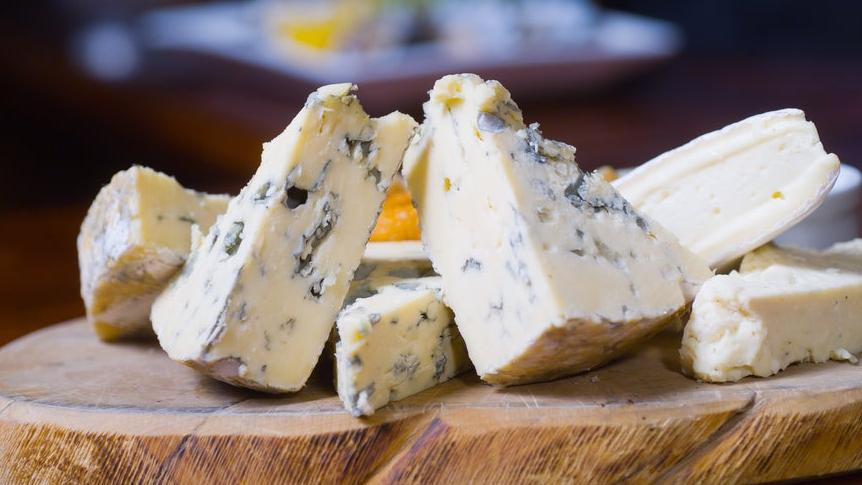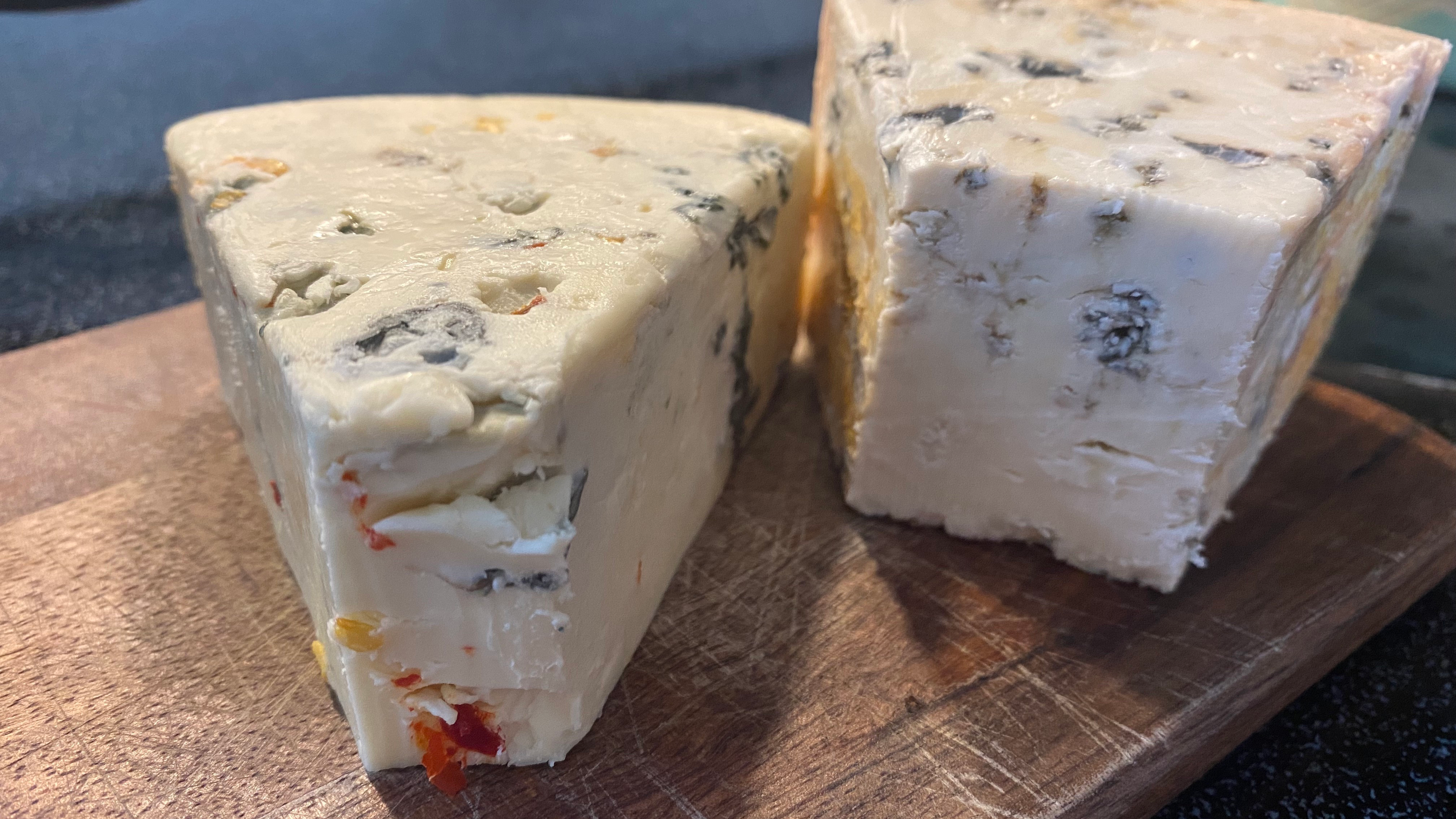How Wisconsin Became The Blue Cheese Capital Of America
The surprisingly colorful century-long history of blue cheese in the United States.
Though it didn't originate in America, the story of blue cheese in the United States is nevertheless one of intrigue, involving government experimentation, ingenuity, and innovation.
The French fairy tale roots of blue cheese
Legend has it that in the 7th century, somewhere near Roquefort, France, a man was eating bread with cheese when he looked up to see a beautiful woman in the distance. He was so taken by her that he stowed his sandwich away in a cool cave and forgot all about it for a couple of weeks, at which point he came back to find that blue cheese had been unwittingly invented, presumably from mold in the cave.
This story of happenstance is a good tale, but it's probably nothing more than that. In 2019, researchers looked into the genetic history of Penicillium roqueforti, the mold that causes the blue in blue cheese, and found that it isn't present in caves, concluding it is unlikely blue cheese was "invented" the way it's presented in legend. It's more likely that the mold was in rye, which made its way into bread, which in turn made its way onto cheese.
Government experimentation
However it originated, Americans on the precipice of the roaring '20s were familiar with blue cheeses from Europe and decided it was high time they got in on the game. In 1918, the United States Department of Agriculture commenced research on how to successfully produce blue cheeses. The research yielded unsatisfactory results and, between 1918 and 1935, more research was conducted at places like the University of Minnesota, Iowa State College at Ames, and the Kraft Cheese Company.
In late 1931 and early 1932, Iowa State College, finding its dairy department's progress on the blue cheese matter unsatisfactory, yanked the project from its dairy department and gave it to its research department. That would prove to be an important move for American blue cheese, because it landed it in the hands of researchers C.B. Lane and B.W. Hammer.
American discovery: Blue cheese’s popularity grows
As the judgment in a 1943 lawsuit details, Lane and Hammer, in the course of their research, figured out that using a homogenizer in the process of making blue cheese resulted in a good, consistent product. A ruling on the matter determined that this amounted to an invention, not simply a use of tools. In the context of the lawsuit, that meant the Toliba Cheese Company, then incorporated in Wisconsin, needed to license the process from Iowa State College, as other cheesemakers had done.
In the text of the judgement, the authoring judge portends that American blue cheese gained popularity in the 1940s because, due to World War II, many of the Danish and French blue cheeses that had previously been imported were no longer available. But, the suit says, if the American way pioneered by Lane and Hammer wasn't superior, why wouldn't American cheesemakers just use Danish or French processes? For the reason, the District Court of the Eastern District Wisconsin ruled that Lane and Hammer's homogenization findings amounted to invention and was at least partially responsible for the cheese's rise in popularity here in the United States.
Lane and Hammer would later conduct research on the role of salting blue cheese during ripening, finding that doing so aids in mold growth and controls flavor defect.
Wisconsin: Blue cheese capital of America?
Though Lane and Hammer's research was rooted in Iowa, Ken's Creamy Wisconsin Blue Cheese claims on its package that its ingredients hail from the "blue cheese capital of America"—Wisconsin. This is not an official distinction the state holds, but several cheese professionals weren't taken aback when I told them told the state was referred to that way.
"I'm not surprised Ken's made that claim," said Abrielle Backhaus, public relations specialist for Dairy Farmers of Wisconsin, in an email last week. "Wisconsin has been making cheese for more than 180 years—longer than it's been a state!"
Indeed, Wisconsin's history is steeped in cheese. Much of the National Historic Cheesemaking Center's timeline of the history of cheese in America focuses on Wisconsin (where the center is also located). Though Wisconsin is known for other cheeses (brick and Colby were invented there) and it continues to lead the nation in cheese production for all sorts of cheeses, it does have a reputation for blues.
A cheesemonger’s theory
Sid Cook, owner of Carr Valley Cheese in La Valle, WI, is a fourth-generation cheesemonger and certified master cheese maker. According to his bio on Carr Valley Cheese's website, Cook has won more top national and international awards than any other cheesemaker in North America.
In an interview last week, he told me he's stopped entering the company's cheeses in some contests. "We just keep winning," he said.
Carr Valley makes a variety of cheeses, including a portfolio of blues, which it makes in a dedicated facility. Asked why Wisconsin, specifically, would be so blue-forward, Cook said he thinks it may be the result of a perfect storm of factors.
First, Wisconsin has both a lot of family-owned cheese factories that have been passed through generations ("I literally grew up in a cheese factory," says Cook), and it has a very competitive cheese master certification program, which involves a decade of experience making cheese followed by three years of intense studies and completion of a lengthy exam.
"Part of the reason we do so many specialty and artisan cheeses is the educational experience that we're offered as well as the art side of the business that we learn from our families," says Cook.
Second, Cook says he thinks changes to the market between the 1950s and 1970s, which led to a lot of Wisconsin cheese producers hanging up their hats, might have inspired more craft-focused pursuits for those that remained. In 1947, the United States began to see rules about pasteurization emerge. In Wisconsin, it's illegal to sell any raw milk products. Cook says the equipment needed to pasteurize milk was too expensive for some smaller producers, which led to their closure.
Moreover, Cook says that in the 1970s, big companies like Kraft and Borden started to favor using one big cheesemaking operation instead of a tapestry of small ones for the production of "commodity cheeses," because doing so yielded a more consistent result.
"Many factories closed because they didn't have a market," says Cook. "It's expensive to be in the dairy business. Valves are costly, and everything is expensive because everything is stainless steel. And it's a slow business. it's the sort of business that it takes a lifetime."
That means a lot of cheese factories closed. Cook says at one time, there were 3,000 statewide, which amounted to a cheese factory every six miles, and today the number is closer to 150. But, he says, the cheese factories that are still in the state largely shifted from commodity cheeses to artisan cheeses.
"Wisconsin cheese makers went from commodity cheese to speciality and artisan cheeses 30, 40, 50 years ago," he says. "The way the cheese business developed here in Wisconsin is really entirely different than how it did in other parts of the country. I'm fourth-generation, and there's a lot of cheese makers who are third-, fourth-, fifth-, sixth-generation cheese companies."
Newer innovations in blue cheese
Cook says the blue cheese making process takes about 90 days, and because his operation is so craft-focused, cheesemaking for him is can be an interesting form of food experimentation. He's found inspiration in creating new cheeses, playing with time-tested processes like blue cheese making. He's recently created blue cheeses with flavor-altering ingredients like Peperoncino peppers and black truffle.
"My wife thinks I should retire," he says, "but I still have a lot I'd like to do."
Cook generously sent me some of his blue cheeses to try. He insisted I couldn't write about Wisconsin blue cheese without having some. His instincts were right (who would question a cheesemonger?); I was glad I had an opportunity to try them. The Peperoncino blue cheese was a standout. It had flecks of pepper like you might expect in a pepper jack, and the spice was a surprisingly good pair for the mushroomy, savory profile of a really good blue. It was unlike any blue I'd ever had.
Cook says that when concocting it, he didn't do a lot of trial and error. Cheesemaking, particularly blue cheese making, is a slow process, and it's not as though you can really try it as it goes. It has to ripen. Mostly, Cook says, when it comes to innovation, you just have go to for it and see what happens.
"You just have to have the get-go to do it," he says. "My dad always used to say, 'You just flip your tail in the air, and let your mane fly, and just do it.' That's how you get things done. You just do it."

